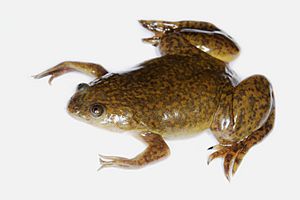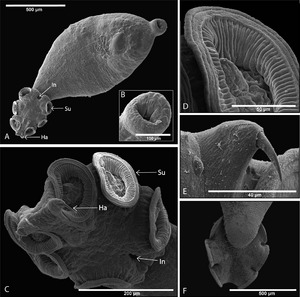African clawed frog facts for kids
Quick facts for kids African clawed frog |
|
|---|---|
 |
|
| Conservation status | |
| Scientific classification | |
| Genus: |
Xenopus
|
| Species: |
laevis
|
| Synonyms | |
|
X. boiei Wagler 1827 |
|
The African clawed frog (Xenopus laevis) is a type of frog that lives in water. It's also called the xenopus or platanna. These frogs get their name from the three small claws on each back foot. They use these claws to rip their food apart! The word Xenopus means "strange foot," and laevis means "smooth."
You can find these frogs in many parts of Sub-Saharan Africa, from Nigeria to South Africa. They have also been found in other places like North America and Europe, where they were brought in by humans. All frogs in their family, called Pipidae, live completely in water. They don't have tongues or teeth. Instead, they use their hands to push food into their mouths.
These frogs have strong legs for swimming and catching food. They also use their claws to tear up bigger food pieces. They don't have outside eardrums, but they have special hidden parts that work like ears. They use their sensitive fingers and great sense of smell to find food. African clawed frogs are like nature's clean-up crew; they eat almost anything living, dying, or dead, and any kind of organic waste.
Contents
About the African Clawed Frog
These frogs are very common in ponds and rivers in southeastern Sub-Saharan Africa. They live in water and are usually greenish-grey. African clawed frogs are often sold as pets. Sometimes, people mistake them for African dwarf frogs. You can also find albino (white) clawed frogs, which are popular as pets or for science studies.
How African Clawed Frogs Reproduce
African clawed frogs lay eggs that are fertilized outside the female's body. The male frog holds onto the female just in front of her back legs. He squeezes her until she releases her eggs, and then he fertilizes them.
These frogs can adapt very well to their environment. They will lay eggs whenever the conditions are right. During rainy seasons, they might travel to new ponds or puddles to find food. If there's a drought, they can dig into the mud and stay there, sleeping, for up to a year!
Xenopus laevis can live for a long time. They have been known to live 15 years or more in the wild. In captivity, they can live even longer, sometimes 25 to 30 years! They shed their skin every season and then eat it.
Sounds and Appearance
Even though male African clawed frogs don't have a vocal sac (a pouch that inflates to make sounds), they can still make a mating call. They use special muscles in their throat to make sounds that go from long to short trills. Female frogs also "talk back." They make a rapping sound if they like the male, or a slow ticking sound if they don't.
This frog has smooth, slippery skin. Its back is multicolored with blotches of olive gray or brown. Its belly is creamy white with a yellow tint.
Telling Males and Females Apart
It's easy to tell male and female frogs apart:
- Male frogs are smaller and thinner.
- Female frogs are larger and rounder.
- Males have black patches on their hands and arms. These help them hold onto the female during mating.
- Females have a more noticeable cloaca (a single opening for waste and reproduction) and hip-like bumps above their back legs where their eggs are stored.
Both male and female frogs have a cloaca. This is a special opening where digestive waste, urine, and reproductive cells all leave the body.
African Clawed Frog Behavior
African clawed frogs live almost entirely in water. They only leave the water to move to new ponds if there's a drought or other problem. They have strong legs that help them move quickly both underwater and on land. Some wild clawed frogs have traveled up to 2 kilometers (1.24 miles) to find new homes. The last three toes on their feet have three black claws. These claws help them tear apart food and scratch away predators.
What They Eat
Clawed frogs are carnivores, meaning they eat meat. They will eat both living and dead prey. This includes fish, tadpoles, worms, insects, and more. They will try to eat anything that fits into their mouths! Since they live in water, they use their sense of smell and a special "lateral line" system (like fish have) to find food. They don't rely on eyesight as much as other frogs do. However, they can still see and will watch prey or predators by sticking their heads out of the water.
Clawed frogs will dig through the mud to find worms and other food. Unlike many frogs, their tongue cannot shoot out to catch food. Instead, they use their hands to grab food and push it into their mouths.
These frogs can even be cannibalistic, meaning they sometimes eat their own kind. Studies have shown that wild clawed frogs sometimes eat large amounts of their own larvae (tadpoles). Tadpoles are filter feeders, meaning they eat tiny plankton. By eating the tadpoles, adult frogs can get these nutrients, which helps them survive in places where there isn't much other food.
Daily Habits
Clawed frogs are nocturnal, meaning they are most active at night. Most of their mating and feeding happens after dark.
When they are not eating, clawed frogs often sit still. They might rest on the bottom of the pond or float at the top with just their heads sticking out.
African Clawed Frogs in the Wild
In the wild, Xenopus laevis live in wetlands, ponds, and lakes in dry or semi-dry areas of Sub-Saharan Africa. They are found along the western edge of the Great Rift Valley. People in Sub-Saharan Africa know this frog well. Some cultures even use it as a source of protein (food) or in traditional fertility medicine.
Wild Xenopus laevis frogs often have different parasites. For example, tiny flatworms can live in their urinary bladder.
African Clawed Frogs as Pets
People have kept Xenopus laevis as pets and for scientific research since the 1950s. They are very tough and can live a long time, sometimes up to 20 or even 30 years when kept as pets.
African clawed frogs are often confused with African dwarf frogs in pet stores. Here's how to tell them apart:
- Dwarf frogs have four webbed feet. African clawed frogs have webbed back feet, but their front feet have separate, unwebbed fingers.
- African dwarf frogs have eyes on the side of their head. African clawed frogs have eyes on the top of their heads.
- African clawed frogs have flat, curved snouts. African dwarf frogs have pointed snouts.
See also
 In Spanish: Rana de uñas africana para niños
In Spanish: Rana de uñas africana para niños




